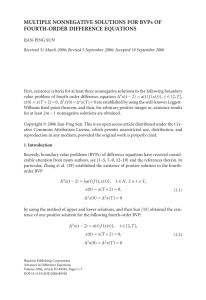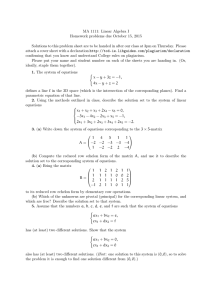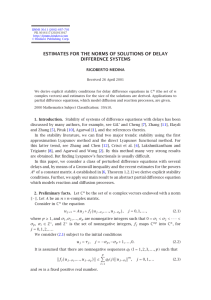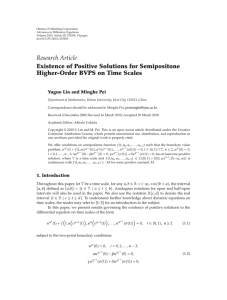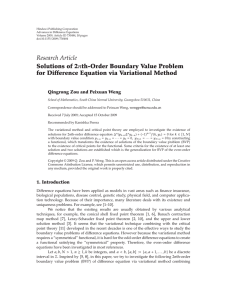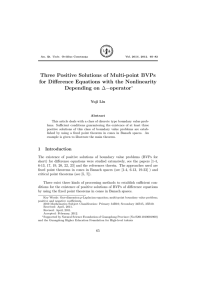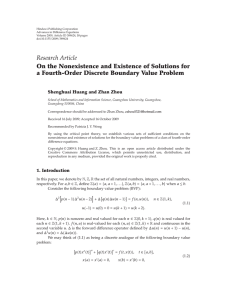POSITIVE SOLUTIONS OF FUNCTIONAL DIFFERENCE EQUATIONS WITH p
advertisement
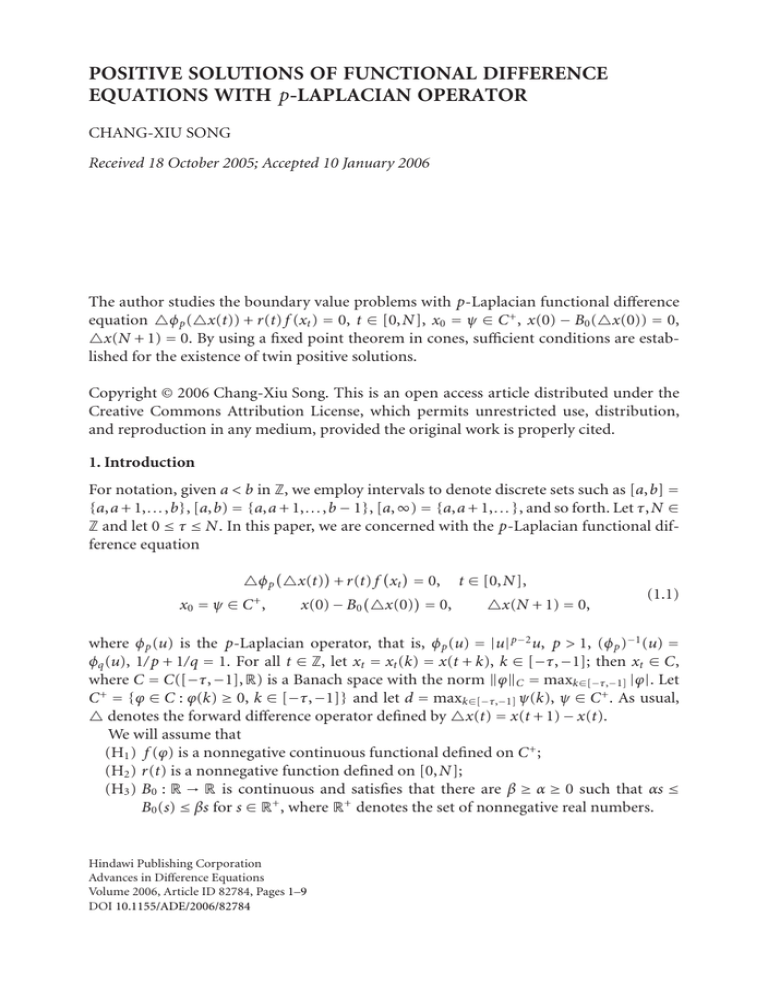
POSITIVE SOLUTIONS OF FUNCTIONAL DIFFERENCE
EQUATIONS WITH p-LAPLACIAN OPERATOR
CHANG-XIU SONG
Received 18 October 2005; Accepted 10 January 2006
The author studies the boundary value problems with p-Laplacian functional difference
equation φ p (x(t)) + r(t) f (xt ) = 0, t ∈ [0,N], x0 = ψ ∈ C + , x(0) − B0 (x(0)) = 0,
x(N + 1) = 0. By using a fixed point theorem in cones, sufficient conditions are established for the existence of twin positive solutions.
Copyright © 2006 Chang-Xiu Song. This is an open access article distributed under the
Creative Commons Attribution License, which permits unrestricted use, distribution,
and reproduction in any medium, provided the original work is properly cited.
1. Introduction
For notation, given a < b in Z, we employ intervals to denote discrete sets such as [a,b] =
{a,a + 1,...,b}, [a,b) = {a,a + 1,...,b − 1}, [a, ∞) = {a,a + 1,... }, and so forth. Let τ,N ∈
Z and let 0 ≤ τ ≤ N. In this paper, we are concerned with the p-Laplacian functional difference equation
φ p x(t) + r(t) f xt = 0, t ∈ [0,N],
x(0) − B0 x(0) = 0,
x(N + 1) = 0,
x0 = ψ ∈ C + ,
(1.1)
where φ p (u) is the p-Laplacian operator, that is, φ p (u) = |u| p−2 u, p > 1, (φ p )−1 (u) =
φq (u), 1/ p + 1/q = 1. For all t ∈ Z, let xt = xt (k) = x(t + k), k ∈ [−τ, −1]; then xt ∈ C,
where C = C([−τ, −1], R) is a Banach space with the norm ϕC = maxk∈[−τ,−1] |ϕ|. Let
C + = {ϕ ∈ C : ϕ(k) ≥ 0, k ∈ [−τ, −1]} and let d = maxk∈[−τ,−1] ψ(k), ψ ∈ C + . As usual,
denotes the forward difference operator defined by x(t) = x(t + 1) − x(t).
We will assume that
(H1 ) f (ϕ) is a nonnegative continuous functional defined on C + ;
(H2 ) r(t) is a nonnegative function defined on [0,N];
(H3 ) B0 : R → R is continuous and satisfies that there are β ≥ α ≥ 0 such that αs ≤
B0 (s) ≤ βs for s ∈ R+ , where R+ denotes the set of nonnegative real numbers.
Hindawi Publishing Corporation
Advances in Difference Equations
Volume 2006, Article ID 82784, Pages 1–9
DOI 10.1155/ADE/2006/82784
2
Positive solutions of difference equations
Recently, the existence of positive solutions of finite difference equations with different
boundary value conditions is investigated in [1–5] and references therein. In this paper,
we consider the functional difference equation (1.1) and apply the twin fixed point theorem to obtain at least two positive solutions of the boundary value problem (BVP) (1.1)
when growth conditions are imposed on f . Finally, we present two corollaries that show
that under the assumptions that f is superlinear or sublinear, BVP (1.1) has at least two
positive solutions. An example to illustrate our results in this paper is included.
We note that x(t) is a solution of (1.1) if and only if
⎧ t−1 N
N
⎪
⎪
⎪
⎨B0 φq
r(n) f xn
+
φq
r(n) f xn ,
x(t) = ⎪
n =m
n =0
m=0
⎪
⎪
⎩ψ,
t ∈ [0,N + 2],
(1.2)
t ∈ [−τ, −1].
We assume that x(t) is the solution of BVP (1.1) with f ≡ 0. Clearly, it can be expressed
as
⎧
⎪
⎨0,
x(t) = ⎪
⎩ψ,
t ∈ [0,N + 2],
(1.3)
t ∈ [−τ, −1].
It is obvious that xn ≡ 0 for n ∈ [τ,N].
Let x(t) be a solution of BVP (1.1) and y(t) = x(t) − x(t). Noting that y(t) = x(t) for
t ∈ [0,N + 2], then we have from (1.2) that
⎧ t−1 N
N
⎪
⎪
⎪
⎨B0 φq
r(n) f yn +xn
+
φq
r(n) f yn +xn ,
y(t) = ⎪
n =m
n=0
m=0
⎪
⎪
⎩0,
t ∈ [0,N +2],
t ∈ [−τ,−1].
(1.4)
Let E = { y : [−τ,N + 2] → R} with norm y = maxt∈[−τ,N+2] | y(t)|, then (E, · ) is
a Banach space.
Define a cone P by
P = y ∈ E : y(t) = 0 for t ∈ [−τ, −1]; y(t) ≥ 0 for t ∈ [0,N + 2],
and 2 y(t) ≤ 0, y(t) ≥ 0 for t ∈ [0,N + 2], y(N + 1) = 0 .
(1.5)
Clearly, y = y [0,N+2] = y(N + 2) for y(t) ∈ P, where y [0,N+2] = maxt∈[0,N+2] | y(t)|.
Define T : P → E by
T y(t)
⎧ t−1 N
N
⎪
⎪
⎪
⎨B0 φq
r(n) f yn + xn
+
φq
r(n) f yn +xn ,
=
n =m
n =0
m=0
⎪
⎪
⎪
⎩0,
t ∈ [0,N +2],
t ∈ [−τ,−1].
(1.6)
Chang-Xiu Song 3
The following lemma will play an important role in the proof of our results and can
be found in [2]. Let
P(δ,e) = x ∈ P : δ(x) < e ,
∂P(δ,e) = x ∈ P : δ(x) = e ,
(1.7)
P(δ,e) = x ∈ P : δ(x) ≤ e .
Lemma 1.1. Let X be a real Banach space, P a cone of X, γ and α two nonnegative increasing
continuous maps, θ a nonnegative continuous map, and θ(0) = 0. There are two positive
numbers c and M such that
γ(x) ≤ θ(x) ≤ α(x),
x ≤ Mγ(x)
for x ∈ P(γ,c).
(1.8)
In addition, assume that T : P(γ,c) → P is completely continuous. There are positive numbers 0 < a < b < c such that
θ(λx) ≤ λθ(x) ∀λ ∈ [0,1], x ∈ ∂P(θ,b),
(1.9)
and
(i) γ(Tx) > c for x ∈ ∂P(γ,c);
(ii) θ(Tx) < b for x ∈ ∂P(θ,b);
(iii) α(Tx) > a and P(α,a) = ∅ for x ∈ ∂P(α,a).
Then T has at least two fixed points x1 and x2 ∈ P(γ,c) satisfying
a < α(x1 ),
θ x1 < b,
b < θ x2 ,
γ x2 < c.
(1.10)
The following lemma is similar to Lemma 1.1; the proof is omitted.
Lemma 1.2. Let X be a real Banach space, P a cone of X, γ and α two nonnegative increasing
continuous maps, θ a nonnegative continuous map, and θ(0) = 0. There are two positive
numbers c and M such that
γ(x) ≤ θ(x) ≤ α(x),
x ≤ Mγ(x)
for x ∈ P(γ,c).
(1.11)
In addition, assume that T : P(γ,c) → P is completely continuous. There are positive numbers 0 < a < b < c such that
θ(λx) ≤ λθ(x) ∀λ ∈ [0,1], x ∈ ∂P(θ,b),
(1.12)
and
(i) γ(Tx) < c for x ∈ ∂P(γ,c);
(ii) θ(Tx) > b for x ∈ ∂P(θ,b);
(iii) α(Tx) < a and P(α,a) = ∅ for x ∈ ∂P(α,a).
Then T has at least two fixed points x1 and x2 ∈ P(γ,c) satisfying
a < α x1 ,
θ x1 < b,
b < θ x2 ,
γ x2 < c.
(1.13)
4
Positive solutions of difference equations
2. Main results
Choose h = [(N + 2)/2], where [x] is the greatest integer not greater than x.
Lemma 2.1. Let T be defined by (1.4). If y ∈ P, then
(i) T(P) ⊂ P;
(ii) T : P → P is completely continuous;
(iii) finding positive solutions of BVP (1.1) is equivalent to finding fixed points of the operator T on P;
(iv) if y ∈ P, then
1
1
y(t) ≥ y = y(N + 2),
2
2
t ∈ [h,N + 2].
(2.1)
The proof is simple and is omitted.
Define the nonnegative, increasing, continuous functionals γ,θ, and α on P by
γ(y) = y(h),
θ(y) = max y(t) = y(h),
(2.2)
t ∈[0,h]
α(y) = max y(t) = y(h).
t ∈[0,h]
We have
γ(y) = θ(y) = α(y),
y ∈ P,
1
1
y(N + 2) =
y for each y ∈ P.
θ(y) = γ(y) = y(h) ≥
2
(2.3)
2
Then
y ≤ 2γ(y),
θ(λy) = λθ(y),
for each y ∈ P,
∀ λ ∈ [0,1], y ∈ ∂P(θ,b).
(2.4)
For the notational convenience, we denote σ and ρ by
σ = (α + 1)φq
N
r(n) ;
n=h+τ
ρ = (β + h)φq
N
(2.5)
r(n) .
n =0
Throughout the paper, we assume that h + τ ≤ N and
N
n=h+τ r(n) > 0.
Theorem 2.2. Suppose that there are positive numbers a < b < c such that
σ
σ
0 < a < b < (c − d).
ρ
2ρ
(2.6)
Chang-Xiu Song 5
Assume that f (ϕ) satisfies the following conditions:
(A) f (ϕ) > φ p (c/σ) for c ≤ ϕC ≤ 2c,
(B) f (ϕ) < φ p (b/ρ) for 0 ≤ ϕC ≤ 2b + d,
(C) f (ϕ) > φ p (a/σ) for a ≤ ϕC ≤ 2a.
Then BVP (1.1) has at least two positive solutions x1 and x2 such that
a < max x1 (t) < b < max x2 (t) < c.
t ∈[0,h]
(2.7)
t ∈[0,h]
Proof. Firstly, we verify that y ∈ ∂P(γ,c) implies that γ(T y) > c.
Since γ(y) = c = y(h), one gets y(t) ≥ c for t ∈ [h,N + 2].
Recalling that y ≤ 2γ(y) = 2c, we know that c ≤ yn C ≤ 2c for n ∈ [h + τ,N].
Then, we get
N
γ(T y) = B0 φq
r(n) f yn + xn
n =0
N
≥ αφq
r(n) f yn + xn
n =0
N
≥ αφq
r(n) f yn
N
= (α + 1)φq
=
c
(α + 1)φq
σ
+
h
−1
φq
N
+ φq
r(n) f yn
φq
N
n =m
r(n) f yn + xn
r(n) f yn + xn
r(n) f yn
n=h+τ
N
> (α + 1)φq
(2.8)
r(n)φ p
c
n=h+τ
N
N
n =m
m=0
n=h+τ
+
h
−1
m=0
n=h+τ
σ
r(n) = c.
n=h+τ
Secondly, we prove that y ∈ ∂P(θ,b) implies that θ(T y) < b.
Since θ(y) = b implies that y(h) = b, it follows that 0 ≤ y(t) ≤ b for t ∈ [0,h] and
b ≤ y(t) ≤ y ≤ 2θ(y) = 2b,
for t ∈ [h + 1,N], y ∈ P.
(2.9)
So
yn + xn ≤ yn + xn ≤ 2b + d.
C
C
C
(2.10)
Then, we have
N
θ(T y) = B0 φq
< βφq
n =0
N
n =0
=
r(n) f yn + xn
r(n) f yn + xn
+
h
−1
φq
m=0
+
N
b
r(n) = b.
(β + h)φq
ρ
n =0
h
−1
m=0
φq
N
n=0
N
n =m
r(n) f yn + xn
r(n) f yn + xn
(2.11)
6
Positive solutions of difference equations
Finally, we show that
P(α,a) = ∅,
∀ y ∈ ∂P(α,a).
α(T y) > a
(2.12)
It is obvious that P(α,a) = ∅. On the other hand, α(y) = y(h) = a implies that
a ≤ y ≤ 2a for t ∈ [h,N],
(2.13)
a ≤ yn C ≤ 2a for n ∈ [h + τ,N].
Thus,
N
α(T y) = B0 φq
≥ αφq
≥ αφq
r(n) f yn + xn
n =0
N
r(n) f yn + xn
n =0
N
r(n) f yn
= (α + 1)φq
N
=
a
(α + 1)φq
σ
N
+
h
−1
+ φq
r(n) f yn
φq
φq
N
N
n =m
N
n =m
m=0
n=h+τ
+
h
−1
m=0
n=h+τ
r(n) f yn + xn
r(n) f yn + xn
r(n) f yn
n=h+τ
> (α + 1)φq
N
(2.14)
r(n)φ p
n=h+τ
a
σ
r(n) = a.
n=h+τ
Hence by Lemma 1.1, T has at least two different fixed points y1 and y2 . Let xi = yi + x
(i = 1,2), which are twin positive solutions of BVP (1.1) such that (2.7) holds. The proof
is complete.
Theorem 2.3. Suppose that there are positive numbers 0 < a < b < c such that
σ
0 < 2a + d < b < c.
ρ
(2.15)
Assume that f (ϕ) satisfies the following conditions:
(A ) f (ϕ) < φ p (c/ρ) for 0 ≤ ϕC ≤ 2c + d,
(B ) f (ϕ) > φ p (b/σ) for b ≤ ϕC ≤ 2b,
(C ) f (ϕ) < φ p (a/ρ) for 0 ≤ ϕC ≤ 2a + d.
Then BVP (1.1) has at least two positive solutions x1 and x2 such that
a < max x1 (t) < b < max x2 (t) < c.
t ∈[0,h]
t ∈[0,h]
(2.16)
The proof is omitted since it is similar to that of Theorem 2.2.
Now, we give theorems which may be considered as the corollaries of Theorems 2.2
and 2.3.
Chang-Xiu Song 7
Let
f (ϕ)
f0 = lim
f∞ = lim
p −1 ;
ϕC →0 ϕ
C
f (ϕ)
ϕC →∞
p −1 ,
ϕC
(2.17)
and choose k1 , k2 , k3 such that
i = 1,2, 0 < k3 ρ < 1.
ki σ > 1,
(2.18)
Theorem 2.4. Let the following conditions be satisfied:
(D) f0 > k1 p−1 , f∞ > k2 p−1 ;
(E) there exists a p1 > 0 such that for 0 ≤ ϕC ≤ 2p1 + d, one has f (ϕ) < (p1 /ρ) p−1 .
Then BVP (1.1) has at least two positive solutions.
Proof. Firstly, choose b = p1 , then
f (ϕ) <
2p1
ρ
p −1
= φp
b
ρ
for 0 ≤ ϕC ≤ 2b + d.
(2.19)
p −1
Secondly, since f0 > k1 , there is R1 > 0 sufficiently small such that
f (ϕ) > k1 ϕC
p −1
for 0 ≤ ϕC ≤ R1 .
(2.20)
Without loss of generality, suppose that
R1 ≤
2σ
b.
ρ
(2.21)
Choose a > 0 so that a < (1/2)R1 . For a ≤ ϕC ≤ 2a, we have ϕC ≤ R1 and a < (σ/ρ)b.
Thus,
f (ϕ) > k1 ϕC
p −1
a
p −1
≥ k1 a
> φp
σ
for a ≤ ϕC ≤ 2a.
(2.22)
Thirdly, since f∞ > k2 p−1 , there is R2 > 0 sufficiently large such that
f (ϕ) > k2 ϕC
p −1
for ϕC ≥ R2 .
(2.23)
Without loss of generality, suppose that R2 > 2b. Choose c ≥ R2 + d. Then,
f (ϕ) > k2 ϕC
p −1
c
p −1
≥ k2 c
> φp
σ
for c ≤ ϕC ≤ 2c.
(2.24)
We then have 0 < a < (σ/ρ)b < (σ/2ρ)(c − d), and now the conditions in Theorem 2.2 are
all satisfied. By Theorem 2.2, BVP (1.1) has at least two positive solutions. The proof is
complete.
8
Positive solutions of difference equations
Theorem 2.5. Let the following conditions be satisfied:
(F) f0 < k3 p−1 ;
(G) there exists a p2 > 0 such that for 0 ≤ ϕC ≤ 2p2 , one has f (ϕ) > (p2 /σ) p−1 .
Then BVP (1.1) has at least two positive solutions.
The following corollaries are obvious.
Corollary 2.6. Let the following conditions be satisfied:
(D ) f0 = ∞, f∞ = ∞;
(E) there exists a p1 > 0 such that for 0 ≤ ϕC ≤ 2p1 + d, one has f (ϕ) < (p1 /ρ) p−1 .
Then BVP (1.1) has at least two positive solutions.
Corollary 2.7. Let the following conditions be satisfied:
(F ) f0 = 0;
(G) there exists a p2 > 0 such that for 0 ≤ ϕC ≤ 2p2 , one has f (ϕ) > (p2 /σ) p−1 .
Then BVP (1.1) has at least two positive solutions.
3. Example
Example 3.1. Consider BVP
φ p x(t) + r x1/9 (t − 1) + x1/3 (t − 1) = 0,
x(t) = ψ(t),
t ∈ [0,4],
(3.1)
t = −1, x(0) = 0, x(5) = x(6) = 1,
where τ = 1, k = −1, N = 4, h = 3, α = β = 0, r > 0 is a constant satisfying Nn=h+τ r > 0,
ψ(t) ≥ 0, d = ψ C = maxk=−1 |ψ(k)| > 0, p = 7/6, q = 7, and f (ϕ) = ϕ1/9 (−1) + ϕ1/3 (−1).
Suppose that ϕ ∈ C + , then ϕC = ϕ(−1).
As ϕC → 0 or ϕC → +∞, we get
f (ϕ)
p −1
ϕC
=
ϕ1/9 (−1) + ϕ1/3 (−1)
p −1
ϕC
(3.2)
(10−9p)/9
(4−3p)/3
= ϕC
+ ϕC
−→ +∞.
We deduce that
ρ = (β + h)φq
N
r(n) = 3
n =0
4
6
= 46875r,
r
(3.3)
n =0
thus, for all m > 0 and 0 ≤ ϕC ≤ m + d, one has
0 ≤ f (ϕ) ≤ (m + d)
1/9
+ (m + d)
1/3
= (m + d)
1/9
m
1− p
(m + d)2/9
+
m p −1 .
m p −1
(3.4)
Define H(m) = (m + d)1/9 (m1− p + (m + d)2/9 /m p−1 ).
Suppose that r and d satisfy
(2d)
1/9
d
−1/6
2/9 1/18
+2 d
1
<
2ρ
p −1
;
(3.5)
Chang-Xiu Song 9
then H(d) = (2d)1/9 (d−1/6 + 22/9 d1/18 ) < (1/2ρ) p−1 holds. So, we can find a p1 = d/2 such
that f (ϕ) ≤ H(2p1 )(2p1 ) p−1 < (p1 /ρ) p−1 for 0 ≤ ϕC ≤ 2p1 + d. By Corollary 2.6, we
know that BVP (3.1) has at least two positive solutions.
Acknowledgment
This research was supported by Natural Science Foundation of Guangdong Province
(011471), China.
References
[1] R. P. Agarwal and J. Henderson, Positive solutions and nonlinear eigenvalue problems for thirdorder difference equations, Computers & Mathematics with Applications 36 (1998), no. 10–12,
347–355.
[2] R. I. Avery, C. J. Chyan, and J. Henderson, Twin solutions of boundary value problems for ordinary
differential equations and finite difference equations, Computers & Mathematics with Applications 42 (2001), no. 3–5, 695–704.
[3] A. Cabada, Extremal solutions for the difference φ-Laplacian problem with nonlinear functional
boundary conditions, Computers & Mathematics with Applications 42 (2001), no. 3–5, 593–
601.
[4] J. Henderson, Positive solutions for nonlinear difference equations, Nonlinear Studies 4 (1997),
no. 1, 29–36.
[5] Y. Liu and W. Ge, Twin positive solutions of boundary value problems for finite difference equations
with p-Laplacian operator, Journal of Mathematical Analysis and Applications 278 (2003), no. 2,
551–561.
Chang-Xiu Song: School of Mathematical Sciences, South China Normal University,
Guangzhou 510631, China
Current address: School of Applied Mathematics, Guangdong University of Technology,
Guangzhou 510006, China
E-mail address: scx168@sohu.com

